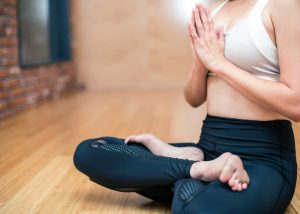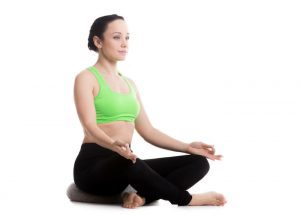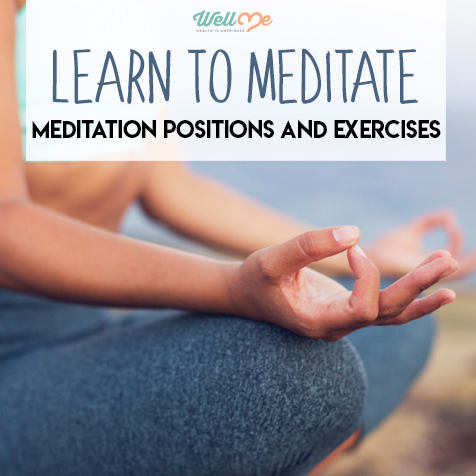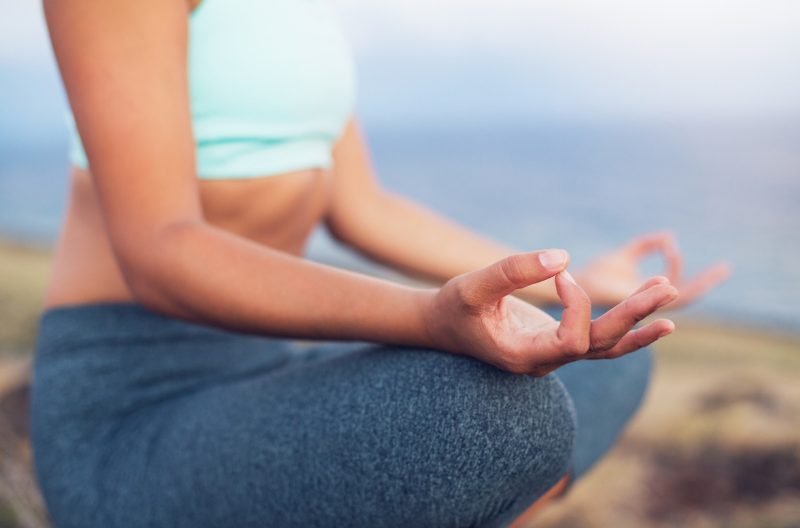Today’s lifestyle is hectic, and it’s almost impossible to add yet another task to your daily routine, let alone some “me” time! When you learn to meditate and regularly engage in meditation exercises, things actually become easier to do. While you may not gain that extra hour in the day that we all need, you will gain the capacity to appreciate every moment and to fill them with all of the things you love.
Learning to meditate is easy because you don’t need much to get started, and you don’t have to put much energy into it. You can start with as little as five minutes a day, a few times a week, and you’ll start to independently spend more time on it. You don’t have to put a lot into it to get a lot out of it.
Once you learn to meditate, it can bring lots of positive change to your life as it can give you more control over your time and your life.[1] You’ll start to see changes in your attitude, your performance, and your capacity to manage tasks.[2] With less stress, life will seem more manageable.[3] You’ll be able to do more with your time, feel happier, and be more satisfied with your life.[4] All this, just by doing some meditation exercises. Not bad, right? If you’d like to start, keep reading to discover some handy meditation tips to get you on the right track.
A Brief Introduction to Meditation

Meditation has been around for centuries. It started in India around 2700 B.C.[5] In America, we really started to see it pop up in the 1960s when it made its appearance in the national culture with the Beatles, Jack Kerouac, and the hippie movement.[6]
Maharishi Mahesh Yogi is a yogi from Uttar Pradesh who developed a new form of meditation called Transcendental Meditation (“TM”). He moved to the United States in 1959 and introduced TM to the world. He started a movement: the movement of sitting still. Since then, we have learned that there are a lot of types of meditation and that learning to meditate can help clear up your mind, your focus, and your life.
Today, meditation is widely known all over the world. The number of people who meditate worldwide is estimated to be between 200 to 500 million.[7] In the United States alone, 8% of the population (approximately 18 million people) meditates.[8] As the world has grown smaller with technology and travel, meditation has crept into almost every culture and country.
Part of the popularity of learning to meditate is that you can do it anywhere, anytime, and without any special equipment or tools. Just bring your focus and willingness, and you can learn to meditate.
What Are the Benefits of Meditation?
The benefits of meditation are one of the reasons why it is so popular.[9] Meditating produces so many benefits that it’s a wonder why we all don’t do it every day! Some of the scientific benefits of learning to meditate include that meditation:
- Reduces anxiety[10]
- Helps manage depression[11]
- Imparts a sense of well-being[12]
- Improves our focus and mindfulness training[13]
- Diminishes stress[14]
- Increases longevity[15]
- Decreases pain[16]
- Reduces insomnia[17]
- Lowers blood pressure[18]
- Helps contain addiction[19]
- Helps with weight loss[20]
While the list of benefits is long, the list of disadvantages is short. Learning to meditate doesn’t take up much time or energy, and it doesn’t cost anything to start. Let’s explore some of the most common types of meditation you will encounter when you learn to meditate.
What Are the Most Common Types of Meditation?
There are many different types of meditation techniques. Each technique can be used to help people with different issues or goals. On top of everything else, it brings you closer to a more tranquil mind and peaceful life.
One of the most basic principles to consider as you learn to meditate is to calm your mind. As your mind wanders, all you have to do is remember to gently guide yourself back to your chosen focus.
The list below is here to help you find that one thing to focus on that will help you quiet and calm your mind, and thus, find a moment of relaxation with every practice. Additionally, you can choose to use any one of them, anytime. There’s no need to stick with just one type!
Breathing Meditation

Breathing meditation is the type of meditation that most of us think of when we start to learn to meditate. This technique simply requires you to pay close attention to your breath and relax your mind. It sounds easier than it actually is, but you’ll get the hang of it with practice. This meditation exercise can be particularly effective in helping to reduce levels of anxiety or stress.
Benefits
How to do
- Get in a comfortable position. You may choose to set a timer for your desired meditation time.
- Close your eyes and clear your mind. Focus your thoughts on nothing else but your breathing.
- Start to take slow, deep breaths. Control your breathing.
- Count your inhales and your exhales silently. Start by inhaling for a measured count of five. Then, count your exhales for a measure of five. If you can only make it to three seconds, that’s okay too!
- If you find your mind starts wandering, pause, refocus, and start counting your breaths again.
Walking Meditation

Walking meditation is an easy way to learn to meditate which focuses on your footsteps and the movements of walking. You simply need sufficient space to walk around to practice this type of meditation. You can start with a few minutes every few days. It will eventually help you to improve your focus with the conscientious attention that you give to each part of each footstep.
Benefits
- Reduces stress[25]
- Reduces anxiety[26]
- Encourages a peaceful attitude[27]
- Focuses the mind[28]
How To Do
- You may choose to set a timer for your desired meditation time.
- In an empty space (such as your garage, basement, or backyard), stand along one wall.
- Begin taking slow, measured steps forward.
- Focus on placing one foot in front of the other. Concentrate on the sensations you feel as each part of your foot touches the ground. From the heel touching the ground, to the ball of the foot, to the toes, and bending them as you continue walking forward.
- When you reach one corner of the room or yard, simply turn the corner and continue walking.
- Clear your mind of all other thoughts except for this measured pace.
- If your mind starts to wander, gently draw it back to the sensations of your feet walking, and of placing one foot in front of the other.
Mindfulness Meditation

Mindfulness meditation is like a breathing meditation, except that your intention is specific: to become more mindful throughout your day. As such, learning to meditate mindfully is geared towards making us more conscientious in everyday living.
In particular, mindfulness meditation asks you to observe. When you learn to meditate using mindfulness meditation, your concentration will return again and again to a calm, cool space of observation: of your breath, of your actions and of yourself.
Benefits
How to do
- Position yourself to meditate. You may choose to set a timer for your desired meditation time.
- Close your eyes and begin to slow your breathing. Bring your focus to your breaths.
- As you inhale and exhale, notice what your arms are doing.
- Now, notice what your legs are doing.
- Next, notice what your mind is doing.
- Notice yourself becoming conscientious of the natural patterns of your body and mind.
- Continue to relax, taking conscious notice of the rhythms of your breathing.
Visualization Meditation

Visualization meditation is a method of using the mind to influence the body. It helps increase your self-awareness and consciousness. It brings more positive energy into your mind and body.
Visualization meditation requires you to first, identify something you would like to achieve or someplace you would like to be. It could be getting a promotion, finally writing that book, or even just in an improved state of health. Whatever that goal is, have it firmly in your mind. You should not change your visualization as you learn to meditate. Just as your goals would remain the same, you should keep visualizing the same outcome/image over and over.
Benefits
How To Do
- Sit comfortably in your chosen meditation position. You may choose to set a timer for your desired meditation time.
- Close your eyes gently and slow your breathing. Clear your mind.
- Begin planning your visualization. Plan to do it exactly as you would have to in real life.
- Visualize yourself in that very position.
- Calm your breathing.
- Remember that it is okay for your mind to wander to something else, but try your best to gently bring yourself back to complete the visualization until it is done.
So, as you can tell, there are many wonderful ways to learn to meditate. It should be something that you enjoy and look forward to, in addition to providing you with all the great health benefits that it is known for.
The Top 5 Meditation Positions for Beginners
We’re all beginners at some things. If you want to learn to meditate and you are just starting out, have a look at these meditation positions for beginners.
Burmese position (cross-legged)

Begin by taking a seat on the floor or a mat. Bring one heel into your groin area. Then, bring the other heel in the front, so you are sitting cross-legged on the floor. Both feet should still be touching the floor. Rest your hands on each thigh, or fold them and place them centrally so your arms are at rest. Keep your spine straight and your chin tucked.
Sitting in a chair
Learning to meditate is as easy as sitting down in a regular chair. You need to keep both feet flat on the floor, and your back must be straight. It is best if you don’t rest your back against the chair. Place your hands either on top of each thigh or folded in your lap. Relax your arms. Keep your chin tucked.
Quarter-lotus

Begin by sitting on the floor or on a mat. Lift one heel onto your opposite thigh. Then, tuck the other heel underneath the opposite knee. One foot should remain on the floor while the other is on its opposite thigh. Rest your hands on each thigh, or fold them and place them centrally so your arms are at rest. Keep your spine straight and your chin tucked.
Kneeling position
This position is just as it says. You can choose to kneel on a meditation mat, or use a meditation cushion or stool to reduce the pressure on your knees. A meditation stool is a small bench that is about a foot high and sits on the floor. Once you are seated on the stool, tuck your feet and calves under the stool, in a modified-kneeling position. You can cross your ankles if that is more comfortable. Your hands should be resting comfortably on each thigh, and your spine should be totally straight.

Below is a quick step-by-step guide to performing a simple beginner’s meditation exercise. Be sure to read our meditation tips further below for optimal results.
- Sit comfortably in your chosen meditation position.
- Set your alarm for three to five minutes.
- Close your eyes. Give yourself a few seconds to get situated. Relax.
- Take a deep, measured inhale through your nose for a count of five. Then, exhale deeply through your nose for a count of five.
- Continue to inhale and exhale deeply, while mentally counting to five. Concentrate on your breath as it deepens and resonates. Try to note how your body feels strong and straight with each inhale, and how your body relaxes with each exhale.
- Finish your meditation with a brief stretch. Bend forward to touch your toes and twist to each side to stretch your back.
- Plan on meditating again in a few days, and then do it!
5 Common Misconceptions About Meditation
- Meditation is a religion
No, meditation is not a religion. Meditation exercises are not associated with any religion, and it does not require you to change your religion to do it. - It requires chanting
Chanting is not required as you learn to meditate. Some people do chant “Om” as they meditate, but it is not required in order to reap the benefits of meditation. - The results will be immediate
As with any exercise, learning to meditate takes some time and consistency to notice the difference it can make in your life. It depends on how consistent you are with your practice. - It requires a lot of time
Meditation practice can take from as little as three to five minutes each day, a few days a week. As your practice develops, you will begin to spend a few extra minutes during each meditation exercise. But it does not take up a huge amount of your time! - It’s boring
With the various types of meditation that you can try, it should not bore you at all. However, as you begin to concentrate your thoughts away from things and ideas, and onto nothing, it may seem like you’re bored. But, that is not the case. What is happening is that you are shifting from a constantly busy mind with a dependent need for stimulus into a different mode of thinking. You are becoming calm – and that is beneficial. Once you let go of your need to be stimulated all the time, you can continue towards a more peaceful sense of meditation.
Follow These Meditation Tips to Get Started
So, you might be asking, how do I begin? Should I ask my doctor about it? Do I need to buy or download anything? Do I need to create a space or avoid certain things in order to begin? To help you out as you learn to meditate, here are some meditation tips to get your started!
1. Find a quiet place

To get the most out of your meditation exercises, you’ll need a quiet place where you will not be disturbed. This is one of the most important meditation tips for first timers as you’ll need to remove as many distractions as possible. The quiet place may be inside your car or in your bedroom. Remember to turn down the lights, turn off your phone, and enjoy a peaceful, tranquil moment.
2. Use a timer

Another of our favorite meditation tips is to use a timer for your meditation exercises. By setting a timer, you can manage your meditation sessions depending on the time you have available. You also don’t have to worry about meditating for too long! There are several apps for clocks and timers that you can download for free. Make sure to select an alarm that has a tranquil, not jarring sound.
3. Be comfortable

You want to find ways to be as comfortable as possible in your meditation so you are not distracted by any discomfort. For example, try to wear loose fitting clothes. If you are not physically flexible, use an ordinary upright chair (like your dining chair) to help get you in a comfortable meditation position. If you’ll be sitting down for long periods, try using a meditation cushion to reduce pressure on your knees and lower back.
4. Keep your spine straight

The most important part of any position in a meditation exercise is to keep your spine straight. That’s why one of the most vital meditation tips to follow is to sit up straight and keep your back in an upright position.
5. Fully commit to it

While there are countless meditation tips to follow, we can’t help but emphasize that it’s okay to take it slow. But always try to keep it in your bullet journal as something for you to do on a regular basis until it becomes a daily practice. Remember to follow through! Learning to meditate can bring life into focus, but you won’t be able to reap its benefits until you depend on it as a part of your regular routine.
If you have any health problems or any concerns if meditation might exacerbate any health issues, definitely ask your doctor for advice on whether meditation exercises are right for you.

Conclusion
If you want to learn to meditate and incorporate regular meditation exercises into your daily life, it’s not as difficult as you might think. Learning how to start meditating is about learning to relax. So, if you lose your focus and have to constantly return to it, don’t stress out! The point is that you are learning to relax, and part of relaxing is to lose focus and to re-focus on something else. Give yourself some space and time to grow into a new practice and see if you can reap its rewards.
References
- [1] https://www.scientificamerican.com/article/meditations-calming-effects-pinpointed-in-brain/
- [2] https://www.psychologytoday.com/us/blog/the-science-behind-meditation/201507/brains-response-meditation
- [3] https://www.psychologytoday.com/us/blog/the-science-behind-meditation/201507/brains-response-meditation
- [4] https://www.psychologytoday.com/us/blog/the-science-behind-meditation/201507/brains-response-meditation
- [5] http://www.mea.gov.in/in-focus-article.htm?25096/Yoga+Its+Origin+History+and+Development
- [6] https://scholarship.rollins.edu/mls/55/
- [7] https://mindworks.org/meditation-knowledge/how-many-people-meditate/
- [8] https://nccih.nih.gov/research/statistics/NHIS/2012/mind-body/meditation
- [9] https://www.ncbi.nlm.nih.gov/pmc/articles/PMC4895748/
- [10] https://www.health.harvard.edu/blog/mindfulness-meditation-may-ease-anxiety-mental-stress-201401086967
- [11] https://www.health.harvard.edu/blog/mindfulness-meditation-may-ease-anxiety-mental-stress-201401086967
- [12] https://greatergood.berkeley.edu/article/item/how_the_science_of_well_being_is_evolving
- [13] https://www.ncbi.nlm.nih.gov/pmc/articles/PMC4895748/
- [14] https://www.ncbi.nlm.nih.gov/pmc/articles/PMC4895748/
- [15] https://www.ncbi.nlm.nih.gov/pmc/articles/PMC3057175/
- [16] https://www.ncbi.nlm.nih.gov/pmc/articles/PMC4895748/
- [17] https://www.ncbi.nlm.nih.gov/pmc/articles/PMC4895748/
- [18] https://www.ncbi.nlm.nih.gov/pmc/articles/PMC3303565/
- [19] https://www.ncbi.nlm.nih.gov/pmc/articles/PMC4895748/
- [20] https://www.ncbi.nlm.nih.gov/pmc/articles/PMC2764526/
- [21] https://www.ncbi.nlm.nih.gov/pmc/articles/PMC5455070/
- [22] https://www.ncbi.nlm.nih.gov/pmc/articles/PMC5455070/
- [23] https://www.ncbi.nlm.nih.gov/pmc/articles/PMC5455070/
- [24] https://www.ncbi.nlm.nih.gov/pmc/articles/PMC5072593/
- [25] https://www.ncbi.nlm.nih.gov/pmc/articles/PMC2764526/
- [26] https://www.health.harvard.edu/blog/mindfulness-meditation-may-ease-anxiety-mental-stress-201401086967
- [27] https://greatergood.berkeley.edu/article/item/how_the_science_of_well_being_is_evolving
- [28] https://www.ncbi.nlm.nih.gov/pmc/articles/PMC4895748/
- [29] https://www.ncbi.nlm.nih.gov/pmc/articles/PMC2764526/
- [30] https://www.ncbi.nlm.nih.gov/pmc/articles/PMC2764526/
- [31] https://www.ncbi.nlm.nih.gov/pmc/articles/PMC2764526/
- [32] https://www.ncbi.nlm.nih.gov/pmc/articles/PMC3718554/
- [33] https://www.ncbi.nlm.nih.gov/pmc/articles/PMC4895748/








